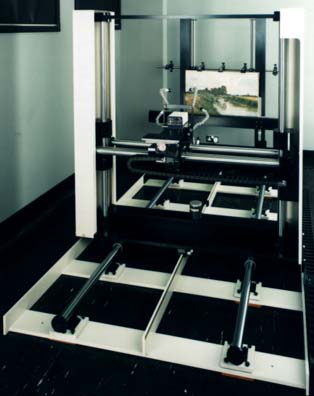
The VASARI project Developed a colorimetric scanner system for direct digital imaging. of paintings. It provides higher colour accuracy than conventional film and high resolution, so it can be used to replace film photography.
Here is an early picture of the VASARI scanner in the National Gallery.

The scanner moves a CCD camera to capture areas which are later "mosaiced" together into a higher resolution image, which is calibrated to CIE Lab values by using images of test charts. The whole scanner can be moved back to allow paintings to be installed. The camera can move slightly forwards/backwards to allow automatic focussing (and hence keep the resolution the same).
The scanner in the National Gallery is used to produce images with 20 pixels per millimetre of paintings from seven colour bands spanning the visible spectrum. These images are so large (our largest is 800MBytes) they require optical disk storage and powerful image processing software. The are used for publishing, scientific analysis and conservation. This includes studies of surface texture and colour change.
A second scanner was built in the Doerner Intitute in Munich which is also used for infra-red imaging. The MUSA project produced a third scanner in the Uffizi Gallery in Florence.
The London and Florence scanner mechanics were built by Time and Precision, Basingstoke UK.
BRAMEUR LTD - UK
DOERNER INSTITUT - D
TELECOM PARIS - F
NATIONAL GALLERY - UK
THOMSON INFORMATIQUE SERVICES - F
BIRKBECK COLLEGE, UNIVERSITY OF LONDON - UK
TÜV - D
GFAI - D
SIDAC SPA - I
SYSECA - F
DIRECTION DES MUSEES DE FRANCE - F
Funded by the European Community's ESPRIT III programme